
MAR · APR · MAY 2023
Aloha,
AS WE CELEBRATE SPRINGTIME and the themes of rebirth, renewal, and regrowth associated with this season, we continue to pursue several paths of change at the museum, critically evaluating how a 21st-century museum best serves its community. We are thrilled to unveil some new ways of shaping transformative art experiences in the coming year, along with incredible exhibitions and engaging public programming.
The freedom to lose oneself in the visual arts is a deeply personal experience, often enhanced by experimentation, inquiry, and space to focus and reflect. It is with this in mind that HoMA re-introduced its Artist in Residence program, which kicked off late last year with Awakening artist Rebecca Louise Law's return to Hawai‘i for a two-week residency at the Art School alongside the museum’s teaching artists. While artist residency programs look a bit different from place to place, they are universally meant to develop greater collaboration between the artist and their hosting institution through the exchange of themes, ideas, techniques, and skills, enriching both the artist and the surrounding community. We look forward to another artist residency later this year, when HoMA will host renowned American sculptor and ceramicist Matt Wedel. His large-scale work Figure with Child (2015) was recently acquired by the museum and is currently on view as part of the Treasures of Devotion installation in Gallery 2.
Another pivotal milestone we'll mark this spring is the reinstallation of the museum’s Arts of Hawai‘i collection in the John Dominis and Patches Damon Holt Arts of Hawai‘i Gallery. Tory Laitila, Curator of Textiles and Historic Art of Hawai‘i, has partnered with guest curator Rory Padeken, born and raised in Ka‘alaea and currently serving as the Vicki and Kent Logan Curator of Modern and Contemporary Art at the Denver Art Museum. Working together, they've reshaped the installation through the thematic lens of landscape—physical and geological as well as social and cultural—revealing narratives from the 19th century to today. Combining historic and contemporary works, the reinstallation will explore and celebrate a sense of place through diverse and multifaceted perspectives. Read
more about the reinstallation process on page 13.
As always, HoMA will continue to host an amazing lineup of exhibitions throughout the year buoyed by programs, events, and art community talks that enliven and explore themes from museum exhibitions and the permanent collection. This spring, we remain spellbound by Rebecca Louise Law’s monumental installation Awakening ; Noah Harders’ intricate, fantastical works in Moemoeā ; the “weeping realism” of Reveries: The Art of Hung Liu ; and the incredible range of permanent collection works in Cross Pollination: Flowers Across the Collection . Later this spring, we’ll investigate the stories and cultural associations of animals in the exhibition Animals in Japanese Art . In the months ahead, HoMA will host Salman Toor: No Ordinary Love , an exhibition of works by the renowned Pakistani American contemporary painter; Transformation: Modern Japanese Art , a celebration of a major gift by collector Terry Welch exploring Japan’s dynamic artistic reinvention; and an upcoming exhibition from Hawai‘i-based artist Lauren Hana Chai. Later this year, we’ll present a major exhibition surveying the groundbreaking prints of acclaimed British artist David Hockney, offering our community a new look at one of the most influential artists of the past several decades. The idea of a 21st-century museum implies innovation, redefinition, and, of course, change. At HoMA, we continue to embrace our future by investing not only in art experiences that reflect and explore the present, but also those that serve to shape the ever-changing world in which we live. We strive to remain ahead of the curve in offering the most meaningful and thoughtful art experiences that we possibly can—and we can’t wait to share what’s ahead!
Warmly,
 HALONA NORTON–WESTBROOK Director & CEO
HALONA NORTON–WESTBROOK Director & CEO

2
EXHIBITIONS
Reveries: The Art of Hung Liu
THROUGH MAY 28, 2023
Paintings and mixed-media works from contemporary Chinese American artist Hung Liu reference both East and West and straddle the line between the personal and the political.
Cross Pollination: Flowers Across the Collection
THROUGH JUNE 4, 2023
A diverse arrangement of artworks from HoMA’s vaults and galleries explores the emotional, psychological, and spiritual resonance of flowers in art.

Animals in Japanese Art
MARCH 30–JULY 23, 2023
This exhibition explores the rich cultural associations of animals in art, which often reveal as much about human society as it does the natural world.
Moemoeā THROUGH JULY 27, 2023
Maui-based Noah Harders’ debut exhibition explores the artist's use of found materials found materials to merge our surrounding ecology with a fantastically imagined world.
Rebecca Louise Law: Awakening THROUGH SEPTEMBER 10, 2023
The debut of renowned British artist Rebecca Louise Law in the Islands, Awakening transforms two galleries into immersive experiences connecting us to the natural world.
3
Gallery 29, Reveries: The Art of Hung Liu on view through May 28, 2023.
SPRING HIGHLIGHTS
PROGRAMS
Connect with museum curators, artists, and creatives from around the world. Register for tickets at What's On: honolulumuseum.org .
Matt Wedel: Clay as a Matter of Learning

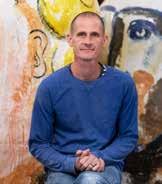
SATURDAY, MAR 11, 7PM •
DORIS DUKE THEATRE
Join renowned ceramicist Matt Wedel in conversation with HoMA Director and CEO Halona Norton-Westbrook and Director of Learning and Engagement Aaron Padilla about Wedel’s artistic process, including his ongoing exploration of the human condition through the materiality of clay.
Conference of the Birds: Sherin Guirguis
FRIDAY, MAR 17, 7PM •
DORIS DUKE THEATRE
Artist Sherin Guirguis discusses her two-part exhibition at HoMA and Shangri La with Shangri La Curator of Collections and Exhibitions

Dr. Leslee Michelsen. Los Angeles–based Guirguis’s show investigates the marginalized and voiceless.
Scent: The Language of Flowers
SATURDAY, MAR 25, 7PM • DORIS DUKE THEATRE
Join Neil Chapman, author of Perfume: In Search of Your Signature Scent, as he discusses the olfactive significance of flowers and perfumes through history, artistry, and physiological elements.
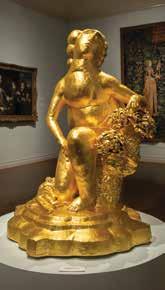
Scent Literacy: A Perfume Appreciation Workshop

SUNDAY, MAR 26, 2PM • KĪNA‘U COURTYARD STUDIO
Inspired by the arrangement of flora-inspired exhibitions on view, perfume expert and author Neil Chapman will lead a workshop deconstructing scents and exploring their sensual characteristics and power, from vintage to current fragrances. Visit honolulumuseum.org/art-classes to register for this special workshop.
4
Matt Wedel (American, born 1983. Lives and works in Athens, Ohio).
Figure with Child , 2015. Ceramic, gold leaf. Courtesy of L.A. Louver Gallery.
Photo of Matt Wedel: McKinley Law. Courtesy L.A. Louver, Venice, CA.
Panic Studio LA.
Flower/Power: Botanical Illustration, Colonization, and Resistance
SATURDAY, APR 1, 7PM •
DORIS DUKE THEATRE
Join Alejandra Rojas Silva, HoMA’s Works on Paper, Photography, and New Media Fellow, for a discussion of botanical illustration from the Renaissance to the present. Explore how the beauty of botanical drawings, prints, and photographs has often concealed the violence of imperial power, and how artists have worked creatively within this genre to assert their own voice.
HoMA Select Talk: Nandi Head
THURSDAY, APR 6, 1PM •
GALLERY 23
Join Curator of Asian Art Shawn Eichman for a conversation about HoMA’s monumental Nandi Head , a centerpiece of the Jhamandas Watumull Gallery and one of the highlights of the museum’s collection of South Asian art.
Nandi Head. India, Kerala, late 18th century. Gift of The Christensen Fund, 2001 (10673.1).

Museums in Times of (Rapid) Technological Change:
Past, Present, and Future
SATURDAY, APR 22, 7PM •
DORIS DUKE THEATRE
From the emergence of electrification and telephonics to the creation of the internet, the rise of NFTs, and virtual reality, new technology creates shockwaves across the museum field. Join Adam Levine, Edward Drummond and Florence Scott Libbey Director of the Toledo Museum of Art, for a conversation about the use of technology in museums across history and into the future.
Live: Museum
Confidential Podcast
FRIDAY, MAY 19, 7PM • DORIS DUKE THEATRE
NPR's 'Museum Confidential' Comes to HoMA May 19

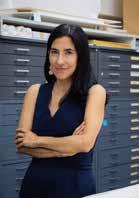
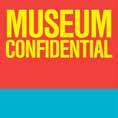
THE POPULAR ART PODCAST “Museum
Confidential,” hosted by the Philbrook Museum of Art's assistant director of communications, Jeff Martin, goes on the road to HoMA on May 19!
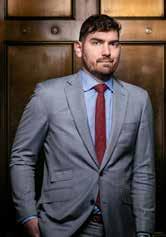
Part of programming for the botanical installation Rebecca Louise Law: Awakening , this live recording will see Martin, along with producer Scott Gregory, interview a special guest. They will, of course, talk about Awakening . The show, the season seven finale, will later air on NPR, Spotify, and other podcast platforms.
“We've talked to so many fascinating artists, museum professionals, critics, journalists, and a few people who defy any conventional description,” Martin said about his podcast. “We've explored the Museum of Bad Art, and the WorldFamous Crochet Museum. We visited the High Museum with [American rapper, actor and activist] Killer Mike and talked trash with John Waters.… We had a spin off season on Native Women artists; we've talked about #MeToo and sexual harassment; problematic histories; the gender disparity in museum collections; labor unions; and, of course, money.” And now he brings his insightful banter to the Doris Duke Theatre.
For more details and tickets go to honolulumuseum.org .
5
Photo courtesy of the Toledo Museum of Art
Scott Gregory and Jeff Martin
Animals in Japanese Art
MAR 30–JUL 23, 2023 • GALLERY 3
ANIMALS IN ART are rarely just animals. They are often rich in cultural associations that reveal as much about human society as the natural world. From Aesop’s fables to contemporary cartoons, depictions of animals have provided us with a means to step outside ourselves and take a fresh look at things we normally take for granted.
Japanese art is rich in animal imagery—humorous badgers, mysterious foxes, divine horses, and fearsome lion-dogs animate a variety of treasures in HoMA’s superb collection.

“Depictions of various animals tell us much about ourselves,” said Shawn Eichman, Curator of Asian Art at HoMA. “Japanese art is abundant in such imagery, from paintings made for the highest levels of court to humble netsuke (miniature decorative carvings) intended for daily use.”
Exhibition highlights include Frolicking Animals , a recent loan to the Tokyo National Museum, where it hung alongside the original twelfth-century paintings that inspired it. An early copy of a set of handscroll paintings, Frolicking Animals depicts various beasts mimicking humans as they play games, dance, make music, and perform religious ceremonies. Another exquisitely painted and rarely displayed work entitled Stable is a six-panel screen from the Momoyama period depicting horses. Hanging scrolls, votive panels, and handscrolls explore stories and meanings behind these animals, offering novel—and sometimes humorous— perspectives on human concerns.
6
NEW
EXHIBITIONS
ABOVE
GALLERY HIGHLIGHT

Big Heads: Portraits by Kitagawa Utamaro
MAY 7–AUG 13, 2023 • GALLERY 21
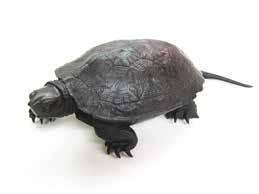
Made possible by the Robert F. Lange Foundation
WHEN COMPARED WITH EUROPE and the United States, Japan’s tradition of portraiture began surprisingly late. The first ōkubi-e (literally, “big neck pictures,” as these prints were originally called) is credited to artist Torii Kiyonobu (1664–1729), published in the first decades of the 18th century. However, the genre didn’t gain popularity among artists until around the 1770s.
Among the earliest portrait artists, one of the most famous was Kitagawa Utamaro (1753–1806). His subjects were primarily the women of the Yoshiwara brothel district: high-ranking courtesans, the young women who served as their attendants, and waitresses who worked in the district’s tea houses. Utamaro frequently identified these individuals by name, and as a result, several of his subjects, such as the courtesan Hanaōgi, came to be celebrated throughout Japan as fashion icons. For contemporary viewers, the images visually document these women’s daily lives, providing fascinating glimpses into personalities and lifestyles of the past.

7
Anonymous. Turtles Japan, Meiji period. Metalwork. 2014-61-03ab. BELOW Anonymous. Stable , Japan, Momoyama period, late 16th–early 17th century. Six panel screen; ink, color and gold on paper. Purchase, 1975 (4279.1).
RIGHT Kitagawa Utamaro (1753–1806). Three Beauties of the Yoshiwara. Japan, Edo period (1615–1868), 1793. Woodblock print; ink, color, and mica on paper. Gift of James A. Michener, 1991 (21877).
New acquisitions
IN NOVEMBER 2022 , HoMA’s collections committee approved the acquisition of two outstanding gifts. The first is Garden , painted in 1934 by the Enomoto Chikatoshi (1898–1973). One of the foremost Japanese artists of the early twentieth century, Chikatoshi is known for his portraits of Japanese women at leisure dressed in Western fashion. In Garden , women hold archery equipment, reflecting the evolution of gender roles in Japanese society at the time. The painting was featured in the fifteenth Imperial Academy of Fine Arts Exhibition (Teiten) at what is now known as the Tokyo Metropolitan Art Museum. Only the most distinguished artists were allowed to participate in these highly competitive, government-sponsored exhibitions.

Around 1945, Garden entered the collection of the Meguro Gajoen Museum of Art in Tokyo. After the museum shut its doors in 2003, the painting was acquired by Patricia Salmon, a longtime supporter of HoMA and an important contributor to the internationally touring exhibition Taishō Chic: Japanese Modernity, Nostalgia, and Deco (2001–2005). HoMA has acquired a substantial collection of modern Japanese paintings through Ms. Salmon’s generous support, and Garden is a spectacular culmination of this relationship.
The second addition to HoMA’s collection is Enrique Chagoya’s Homage to Goya II: Disasters of War , a portfolio of ten aquatint prints produced between 1983–2003 and printed in 2003. Eight of these works put a contemporary spin on Francisco Goya’s (1746–1828) famous Disasters of War (1810–1820). Goya’s prints, kept secret during his lifetime, denounced Napoleon’s brutal occupation of Spain. Chagoya meticulously copied eight of Goya’s works, adding uncanny details and satirical substitutions that address issues of
American imperialism, border politics, and the art market. The remaining two prints, created in Goya’s style, present the artist as an heir to both Goya and the famous Mexican satirist José Guadalupe Posada.
HoMA’s permanent collection includes all of Goya’s prints in the Disasters of War series. The addition of Chagoya’s Homage offers the opportunity to bring the outstanding nineteenth- century Spanish artist into conversation with one of the most prominent Chicano artists working today. The portfolio was generously donated by Diane Evans, formerly curator of the Nevada Museum of Art in Reno and who served for nine years as executive director of the Museums of Sonoma County before moving to Honolulu in 2019.
8
Enomoto Chikatoshi (Japanese, 1898–1973). Garden (Niwa) , c. 1934. Nihonga painting; ink and color on paper. Gift of Julia Meech.
GALLERY HIGHLIGHT
Jaume Plensa’s HORTENSIA (nest)
HORTENSIA (NEST) by renowned Spanish artist Jaume Plensa has joined the installation In Human Terms in HoMA’s Gallery 1, thanks to a generous loan from HoMA Trustee Sharon Twigg-Smith. The installation brings together a range of perspectives on the human figure, from some of its earliest manifestations in the ancient world to its enduring presence and power in contemporary art.
HORTENSIA , which weighs nearly 2,400 pounds, is a striking contrast between rough stone and a serene portrait of a young woman—Plensa describes his work as merging the exactness and immediacy of photography with the solidity and endurance of sculpture. Beginning with a three-dimensional scan of his subject’s head, the artist subtly distorts the digital image then transfers it to the stone with a precision milling process. Although his works depict specific people, Plensa’s portrait sculptures attempt to capture something universal about the body and the human experience.
HORTENSIA is part of the artist’s Nest series. The figure emerging from a block of luminous alabaster recalls the words of Michelangelo, who said the sculptor’s task is to release the figure that already exists within the stone. “For me,” Plensa says, “the head is the nest where our dreams are born.”

9
Jaume Plensa (b. 1955. Lives and works in Barcelona, Spain). HORTENSIA (nest) , 2021. Alabaster. Collection of Sharon Twigg-Smith.
Process over product
FOR AARON PADILLA, HoMA’s Director of Learning and Engagement, reimagining the museum’s Artist in Residency program began with the tiny pieces of plastic that wash up on the shores of O‘ahu. He had taken UK-based artist Rebecca Louise Law, at her request, to the beach. It sounds like an obvious first destination for a visitor. But for Law, it wasn’t an exercise in reconstructing a tourist’s view of the island. It was because she had heard about the damage of marine plastics and wanted to see the impact firsthand.
That visit made such an impression on Law that it carried through to her work as an artist. For the first time in her career, she incorporated this type of human-produced waste into her nature-based installations, additions she hoped would reflect the dire consequences of our actions on our environment’s health.
It was a prime example of the cultural exchange that happens when artists come to the Islands—the impact of Hawai‘i on the artist, and of the artist on Hawai‘i. The experience inspired Padilla to relaunch an artist residency program at the Museum, with Law as the first participant, to facilitate cultural exchange and learning between an artist and the museum. Law returned to the island in December 2022 and spent two weeks learning from HoMA’s teaching artists, enriching their practices with her own fresh perspectives.

10
HoMA's new Artist in Residency program creates space for artists and the community to learn, make, and connect
One of the primary goals of the HoMA Artist in Residency program will be to shed more light on the artistic journey and cross-pollinate ideas and techniques as contemporary artists from around the world are invited to participate. The influences of the residency are intended to be deeper and more open-ended than a one-off project.

“Art is a process, and what we see hanging in our galleries are just snippets of a long film,” Padilla said. “You can view and interpret and read a work of art as it stands, but if you understand what has gone into creating it and if you’re privy to the broader context of an artist’s path, it makes the work a lot more enriching.” Padilla hopes each residency will reflect the artists involved, and include things like community conversations and opportunities to see artists creating or engaging with local artists and museum team members.
For Law, it was an opportunity to gain new techniques and grow without the pressure of deadlines or a final project. “Each session that I had with a teacher planted a seed in me,” she said. “It didn’t necessarily matter what was produced, it was teaching me how to work with different materials in different ways and putting that confidence in me. The teachers here were incredibly generous with their time and ideas, and I’ll take that with me.”
The exchange allows the museum to support contemporary artists and the art world beyond the museum’s walls, according to HoMA Director Halona Norton-Westbrook.
“Creative endeavors need nourishment, and artists need space and opportunities to create and learn,” Norton-Westbrook said. “It’s imperative for our institution to serve as a guide and an encouraging force in contemporary art making, not only housing completed works but inviting education and exploration. We’re grateful for the opportunity to connect influential contemporary artists with our HoMA community.”
The next participant, Ohio-based sculptor Matt Wedel, is slated to begin work at HoMA in summer 2023.
Understanding how art is formed—from the first sparks of an idea to the final displayed work, inception to completion—is one of the key principles of the new Artist in Residency program. Padilla says with the reopening of the Art School and the importance of art education to HoMA’s mission, it makes sense to reintroduce a residency program that centers on learning over finished works, prioritizing the creative journey in a cultural environment often hyper-focused on results and final products.
“Our residents will need to be artists, teachers and students—I think great residents are all three,” Padilla said. “Great artists are open and curious to what’s out there. They’re receptive to different ideas and perspectives and have the ability to synthesize and create. Hopefully this program can create a space for all of that to happen.”
11
OPPOSITE Marine debris in Rebecca Louise Law's Awakening. ABOVE Aaron Padilla and Rebecca Louise Law at Pounders Beach.

Reframing the landscape
John Dominis and Patches Damon Holt Arts of Hawai ‘ i Gallery will debut a reinstallation with new curatorial perspectives in spring 2023
REINSTALLING the museum’s Arts of Hawai‘i gallery was an immense task.
Nearly 200 works needed to be narrowed down to 40 for display. A new approach to storytelling had to be adopted, one that made space for new narratives to be told with the permanent collection’s works. And it would need to be collaborative, reflecting varied perspectives from different historians and art experts.
The key that unlocked a project that required so much fresh thinking came, though, from the most unexpectedly expected place: portrayals of landscapes.
It’s a familiar artistic construct, particularly in Hawai‘i, with its abundance of natural beauty. But the curators used landscapes as the frame for exploring deeper aspects of the archipelago’s identity—its social, political, cultural, and geographical layers.
The results will debut in spring 2023 in the John Dominis and Patches Damon Holt Art of Hawai‘i Gallery. The reinstallation—made possible thanks to the support of Judy Pyle and Wayne Pitluck— celebrates the dynamic visual culture of Hawai‘i, featuring works from HoMA's permanent collection and a few strategic loans across a variety of media and expressions.

13
Jules Tavernier, View of the Pali , c. 1886. Oil on canvas. Purchase, 1996 (8090.1).
The landscapes theme came from the co-collaborators behind the reinstallation: Tory Laitila, HoMA’s Curator of Textiles and Historic Arts of Hawai‘i, and Rory Padeken, the O‘ahuraised guest curator currently serving as the Vicki and Kent Logan Curator of Modern and Contemporary Art at the Denver Art Museum. They intend to show a more rich and nuanced view of landscapes in all their layered meanings, rather than the traditional idea of postcard-like views of beautiful places.
“We’ve gathered artworks made from the nineteenth to twentieth centuries that show various places throughout the islands that are not Waikīkī or Lē‘ahi (Diamond Head), places and views of the land that you wouldn't necessarily find on a postcard or in a travel brochure,” Padeken said. “I am excited for visitors to see a group of engravings made between 1834 and 1844 by American Protestant missionary artist Edward Bailey alongside work by Native Hawaiian students and engravers who depicted various places on the islands of Maui and Hawai‘i. They are the complete opposite of his paintings that offer Eden-like views of Hawai‘i. In many ways, the engravings are more immediate and show Hawai‘i in transition as Western development begins to reshape the land. However, markers on the land that signify a Native Hawaiian sense of place also appear: the coconut groves that line the shore and traditional dwellings thatched with pili grass.”
The reinstallation explores the broad and varied identities that make up the culture of the islands and their artistic communities across centuries: Japanese and Filipino influences, immigrants from Korea and Micronesia, displaced Europeans, Scots who married into the Hawaiian monarchy—all are part of the historic fabric and society of Hawai‘i.
“This reinstallation will show the broadness of the ethnicities of the people and the artists represented, including Native Hawaiian and artists that worked, lived or were born in Hawai‘i,” Laitila said.
“People talk about Hawai‘i as a melting pot, but I like the word ‘stew,’ because we’re all combined
and still retain our identities,” he continued. “Living here means you live in multiple communities and societies simultaneously. We live and work in all these layers, and those layers make up our landscape.”
It will also show the broad mediums employed by artists here: Theodore Wores’ 1901 oil painting The Lei Maker , one of the treasures of HoMA’s collection, will remain on view. Woodwork, like an ‘umeke poi from the eighteenth century, as well as quilting, feather work, engraving and printmaking will be on view as well. Artists like Lionel Walden, James Gay Sawkins, Isami Doi, Sean Browne, Marguerite Blasingame, and Reuben Tam will be represented.
Visitors will experience this expanded vision on both ends of the museum: more contemporary works toward the back of the gallery will be bookended by those in HoMA’s Gallery 14, where the focus will be on frequently changing exhibitions of contemporary art by local artists.
Reinstallation and reinterpretation of collections has become a common project and topic of conversation across museums in recent years as they seek to tell more authentic stories through their collections, part of the broader cultural push towards inclusivity.
“The traditional, chronological ways of telling histories at so many museums across the world often reinforce a linear or accepted canon of how things happened,” said Catherine Whitney, HoMA’s Director of Curatorial Affairs. “Reinstallation, if done well, can open up conversations and break down that canon of patriarchal, colonizing narratives so that we can tell new stories that are more diverse and more inclusive.”
Whitney says it was important to the curatorial team who worked on this iteration to approach it with a collaborative spirit, with the aim of sparking conversation rather than authoritatively defining past histories.
“The hope is that we are not just teaching a history or pointing to the past, but also showing how powerful these themes still are,” Whitney said. “The works are addressing some of the same human and societal issues we’re still grappling with today.”
14
“Reinstallation...can open up conversations and break down that canon of patriarchal, colonizing narratives so that we can tell new stories"
Kaili Chun, 'Ama 'ama, 2018. Digital print on archival paper. Anonymous gift, 2018 (2018-24-01.03) 2018-24-01.03.
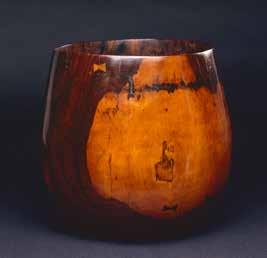


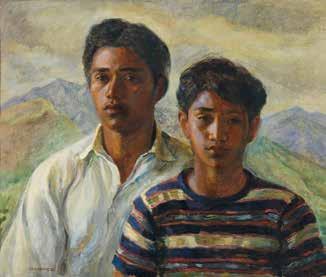
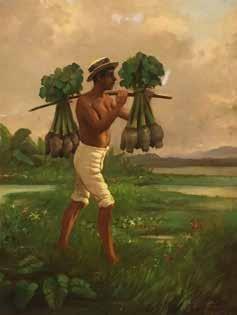
15
CLOCKWISE FROM TOP LEFT
Joseph Strong, Man with Yoke Carrying Taro, 1880. Oil on canvas board. Bequest of Patches Damon Holt, 2003 (12692.1).
'Umeke Poi (poi bowl), 18th century or earlier. Kou wood. Gift of Anna Rice Cooke, 1927 (3063).
Isami Doi, Kauai Landscape—Hanapepe Valley, 1946. Oil on canvas. Gift of J. Russell and Charlotte L. Cades, 1992 (6892.1).
Mabel Alvarez, The Brothers Moses and John, 1940. Oil on canvas. Gift of The Contemporary Museum, Honolulu, 2011, and gift of the artist (TCM. 1983.3.1357).
Welcome back, Jessica Welch, HoMA's new Chief Advancement Officer
The Honolulu Museum of Art’s new Chief Advancement Officer is no stranger to the museum—in fact, the newest member of HoMA’s leadership team worked here for thirteen years before departing in 2016 to become Executive Director of the Mānoa Heritage Center. “We’re thrilled to welcome Jessica back, and are fortunate that she is already so familiar with the museum’s history and fundraising needs,” said CEO and Director Halona Norton-Westbrook. “Her background in museum development and deep local connections will have a tremendous impact on our ability to serve this community for many generations to come.”

Welch returned to the museum in January. As head of the Advancement team, she’ll be responsible for raising HoMA to new levels of charitable funding, through major gifts, membership, fundraising events, and grants, and will collaborate with the Director and Board of Trustees to lead the museum’s strategic development efforts.
“I’m excited to return to the place where I spent most of my formative professional career,” Welch said. She described how walking the museum grounds brings back years of memories and feels like a homecoming. “When my daughters were small, they were always at the museum with me. Now returning as teenagers, they remember so much about the art and events we shared here years ago. Watching them engage with this place in new ways made me realize how special it is—I'm looking forward to building new memories at HoMA.”
Prior to being named executive director at Mānoa Heritage Center, Welch wore many hats at HoMA: over the years, her various titles included Associate Director of Development, Foundation Relations; Director of Institutional Planning & Support; and in 2013, Director of Development. In her three years as Director of Development, she launched a successful new membership program and built a highfunctioning Development team responsible for major gifts, planned giving, foundation grants, corporate sponsorships, membership, annual giving, and fundraising events.
“Over the course of my time at HoMA, I saw firsthand the huge impact that art makes in peoples’ lives,” Welch said. “And while the museum has always been a treasured resource, it’s been re-energized with a fresh vision and new strategic plan. It’s an honor to be part of this team embarking on truly transformative work.”
16
The HoMA community was deeply saddened by the December 2022 passing of Steve McClaran, a beloved member of the museum ‘ohana. Born and raised in Honolulu, with a distinguished U.S. Navy career and a small business of his own, McClaran was a dedicated docent for many years, volunteering at the museum well into his 90s. McClaran’s wife, Patsi, ran the front desk for over twenty years, and as a couple they were devoted to the museum.

The docent community remembers McClaran as the consummate museum guide: incredibly kind, well-researched, and willing to share. “We’re all better people for knowing Stephen,” said Vicki Reisner, former Director of Volunteer and Visitor Services, who believes he may have been one of the museum’s first male docents. "One of the most remarkable things about him was that he was the expert on museum founder Anna Rice Cooke. He conducted tours centered around works of art that she donated to the permanent collection—he brought her back to life.”
In 2007, McClaran co-curated an exhibition with then museum Director Stephen Little titled A Vision of the World: The Anna Rice Cooke Collection at the Honolulu Academy of Arts exploring how Cooke built

IN MEMORIAM: Steve McClaran
her remarkable collection, her intellectual curiosity, and her commitment to education as the foundation for the museum’s mission. “Stephen embodied the spirit of this place,” said Director of Learning and Engagement Aaron Padilla. “He approached everything with an open-minded eagerness to learn and brought that same enthusiasm when sharing HoMA’s gifts with our community.”
McClaran’s influence continues to be felt at HoMA through the friendships he forged and knowledge he shared. Former Curatorial Assistant Amber Ludwig Otero recalls reinstalling HoMA's porcelain collection with McClaran as her righthand man. “I told him that I was inspired by the porcelain room at the Seattle Art Museum,” Otero remembers, “and Stephen came back the next day with a diagram of how we could install our collection, and that’s what we used. The wall is still up today.”
To all who knew him, McClaran’s love of the museum—and the museum community—was evident. "He was in every piece of the museum,” said Otero. “And he gave the best life advice. The depth and breadth of the lives he touched is great.”
17
Steve McClaran at the A Vision of the World: The Anna Rice Cooke Collection opening reception, 2007.
Linda Strong
A small ceramic oil lamp sits on a shelf in the Lending Collection, pale terra cotta in color and encased in a plexiglass box. Picking up the box, longtime museum volunteer Linda Strong speculates that the lamp isn’t a replica, but an authentic artifact dating back to the Roman Empire. It’s one of the many treasures she’s grown familiar with over years of working with the objects housed in the Lending Collection, which represent cultures across the globe and throughout history.
The oil lamp is surrounded by a neatly organized array of items in the collection’s Rome section, just a few shelves down from the Egypt section, home to small-scale models of the Sphinx, tile fragments bearing hieroglyphs, and a centuries-old painter's palette. Turning to a shelf labeled “Japan,” Strong points out a set of nesting lacquer bowls, a gift from Prince Komatsu Akihito, who presented the bowls to museum founder Anna Rice Cooke after the Russo-Japanese War in recognition of her support of the Japanese Red Cross.
Each of these artifacts and artworks are available for borrowing by Hawai‘i educators who use them to supplement classroom curriculum with object-based learning—meaning physical items that kids can see and touch. In addition to being an ardent believer in hands-on learning, Strong is the great-granddaughter of Anna Rice Cooke, and carries on Cooke’s personal commitment to an institutional responsibility to provide educational resources for the children of Hawai‘i.
A former art and art history teacher and currently practicing artist, Strong has been working with the Lending Collection for over twelve years. She was a key part of the initial effort to reimagine possibilities for the object-based learning program and reorganize its thousands of objects and artifacts—a collaboration between the Board of Trustees’ Education Committee, curatorial staff, experts from the community, and other dedicated volunteers.
These days, much of her volunteer time is spent preparing materials to lend out, guiding educators
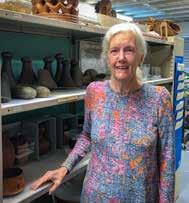
in finding objects that connect to their lesson plans, assembling loan requests, repairing or mending items, and maintaining the ever-growing files of art reproductions, prints, and images. Strong uses her skills as a book artist to create special demonstration boards or boxes to be used as teaching tools.
Walking over to shelves displaying art and artifacts from Hawai‘i, Strong explains that she’s always had a personal connection to these items, in part due to her mother’s work as an archaeologist at Bishop Museum. “When I’m spending time with these objects from our host culture, I channel her,” she says. “I’m always amazed at the knowledge I picked up from watching her work.”
During the Lending Collection’s reorganization, Strong came across a number of historic kapa fragments and decided to make them available to educators. She enlisted the help of Carol Silva of the Hawai‘i State Archives, who taught her how to create archival matting. “So, the first thing I did was mat all the kapa samples,” Strong recalls, “and I just fell in love with them.” Holding one of the swatches up to the light, Strong points out visible marks from the kapa beaters. “I’ve learned so much in my time here, and find it incredibly rewarding to help teachers integrate art, art history, and objects into their curriculum.”
Her advice for someone interested in volunteering at HoMA? “There are so many different volunteer opportunities across the museum, and many ways that someone can contribute. You can find something you like—something you’re naturally enthused about—and bring that energy to the museum."
18
VOLUNTEER SPOTLIGHT
Mahalo, HoMA volunteers!
10,071: that’s the total number of service hours HoMA’s volunteers donated in 2022. April is National Volunteer Appreciation Month, and we extend our heartfelt gratitude to the more than 150 individuals who so generously give their time and talent to the museum. HoMA's volunteers are an essential part of museum operations, leading inspiring and informative museum tours, bringing floral art to life in the hallways, facilitating community artmaking activities, helping to keep the museum library and collection in order, and engaging with the community at special events. Curious about volunteering? There are many different opportunities available to fit a variety of schedules and interests. To learn more, visit honolulumuseum.org/ volunteer-program.
MATERIAL CONNECTIONS:
The Lending Collection
Ceramics and currency, masks and musical instruments, textiles and toys—HoMA’s Lending Collection contains thousands of artifacts and objects from around the world. These portable, tangible examples of art and culture are provided as free teaching tools for Hawai‘i educators to borrow and use, allowing them to activate classroom lessons with objects that students can see and touch. Located in the basement of the Art School, the Lending Collection has been part of the museum since it opened in 1927. Originally comprised of works from founder Anna Rice Cooke’s own collection, objects in the lending library have been used for decades to bring art, history, and culture to life in classrooms across the state. Today, the Lending Collection is home to over 10,000 donated items, each providing a different opportunity for object-based learning: a bisected nautilus shell is a physical example
of the golden ratio, a patterned ceramic tile from Portugal illustrates the concept of radial symmetry, and historic paper money from the Republic of Hawai‘i makes a material connection to the past.
HoMA’s Interpretive Resource Manager Janna Plant, part of the museum’s Learning and Engagement team, oversees the Lending Collection. “Objects carry narratives from the people who created them,” Plant explained. “The Lending Collection helps educators and their students activate these stories and deepen their understanding and empathy for the cultures and histories of our global community.”
For more information, visit honolulumuseum.org lendingcollection.
Items

19
from the Lending Collection (left to right): Norwegian lunch box, nautilus shell, reproduction of certificate of deposit from the Republic of Hawai‘i, theatrical headdress from a Chinese opera, dyed goose feathers for use in modern Hawaiian featherwork, reproduction of an ancient Pompeiian dinner bell, Japanese akabeko.
HoMA reaccredited by the American Alliance of Museums

In late 2022, HoMA joined a group of prestigious museums across the country when it was awarded reaccreditation by the American Alliance of Museums (AAM)—for a museum, the highest level of national recognition. Accreditation is a marker of excellence to the museum community, government entities, funders, outside agencies, and the museumgoing public. It’s a huge accomplishment: of the nation’s estimated 33,000 museums, only 1,090 are currently accredited. In fact, the Honolulu Museum of Art is one of only five museums accredited in the state of Hawai'i.
“This achievement is the direct result of the long-term guidance of our board and the hard work and dedication of all of our staff,” said Director and CEO Halona Norton Westbrook. “We are incredibly honored to be reaccredited by AAM, which not only affirms HoMA’s quality and credibility among the national museum community, but also reaffirms our commitment to providing transformative art experiences for our local community.”
Good for ten years, accreditation is awarded to a museum for its commitment to excellence, accountability, high professional standards, and continued institutional improvement. Developed and sustained by museum professionals for over 50 years, AAM’s accreditation program is the museum field’s primary vehicle for quality assurance, self-regulation, and public accountability.
A rigorous but rewarding process, accreditation examines all aspects of a museum’s operations: to earn accreditation, a museum first must conduct a year of self-study, and then undergo a site visit by a team of peer reviewers.
“Accredited museums are a community of institutions that have chosen to hold themselves publicly accountable to excellence,” said Laura L. Lott, AAM President and CEO. “Accreditation is clearly a significant achievement, of which both the institutions and the communities they serve can be extremely proud.”
20
SPECIAL EVENT
Avant Garden 2023
Join the HoMA community on Saturday, April 29, 5:30–9pm, for Avant Garden, a special event celebrating creativity in all forms with immersive art experiences across the museum. Step into the galleries for poetry, dance, serenades, a sound bath, and performances inspired by the museum collection and exhibitions. Outdoor entertainment will include danceable DJ sets, live music from local musicians, and a mesmerizing, one-of-a-kind 3D projection mapping experience in HoMA’s Central Courtyard.
Enjoy drinks and botanical cocktails by Stir Beverage and garden party-inspired fare by HoMA Café, Chicken & Brisket, and Bubbly & Bleu—offering their signature pre-order personal baskets. Avant Garden is the perfect setting to dress to impress in creative cocktail attire.
Tickets go on sale March 16, $125 for members and $150 for non-members. See details and purchase tickets at honolulumuseum.org/avantgarden .

New menu items and online reservations
Good news for fans of the Café's classic White Bean Salad: a recent mainstay of the daily specials board, the cult favorite has been given a permanent spot on the lunch menu. The Café’s evening offerings have expanded to include favorites like the Filet Mignon Sandwich and Smoked Salmon Crostini, and more options for keiki. Best of all, the HoMA Café is now accepting reservations online! Book a table for lunch or brunch at honolulumuseum.org/cafe . For large party reservations or special requests, please call the Café directly at (808) 532-8734 . Reservations are not available for bar service during HoMA Nights.
21
H o MA CAFÉ NEWS
Honolulu African American Film Festival 2023 Opening Reception
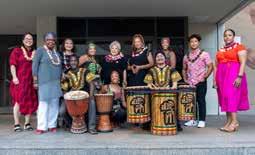
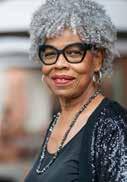
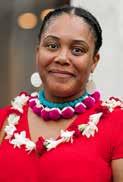
The fourteenth annual Honolulu African American Film Festival returned to the Doris Duke Theatre in February with an outstanding lineup of features, documentaries, and shorts from throughout the African diaspora celebrating the breadth of Black experiences from across the country. The festival’s opening-night reception was held in HoMA’s Luce Pavilion and included dinner, vibrant dance and drum performances from Sewa Fare', and a screening of Lowndes Country and the Road to Black Power. Thank you to all who joined us, and a special mahalo to the Honolulu African American Film Festival (HAAFF) committee: Daphne BarbeeWooten, Ethan Caldwell, Akiemi Glenn, Tadia Rice, Sandra Simms, and Sharon Yarbrough.

22
TOP Sarah Fang (far left), Theatre Manager & Programmer, the Honolulu African American Film Festival committee, and Sewa Faré. BOTTOM Dr. Akiemi Glenn, Ava Beamon.
Kama ‘ āina Christmas 2022

MAHALO NUI to everyone who made December's Kama‘āina Christmas event an evening to remember— and one of the most successful museum fundraisers in years! The black-tie affair featured in-gallery dining with elegant cuisine from Chef Roy Yamaguchi, live entertainment, guests dressed to the nines, and merry moments shared among the museum community. We are incredibly grateful to each of you who contributed to this year’s event: table purchasers, wish tree donors, live auction participants, guests, and museum staff. Funds raised at Kama‘āina Christmas directly support the museum’s mission to inspire and uplift our community through transformative art experiences that celebrate creativity, cultivate wonder, foster empathy, and enhance knowledge in order to deepen our connection with one another and the world we share.

23
Honolulu Museum of Art staff.
PLATINUM BENEFACTORS
Bank of Hawai‘i
Batra Family and Friends

Cartier
Christmas Lovers Table
C.A.R.E. (Crazy Art Revelers Everlasting)
Jay Shidler on behalf of
The Shidler College of Business
Tori Richard, Ltd.
GOLD BENEFACTORS
Margery Bronster
First Hawaiian Bank
David & Kathy Moore
Neiman Marcus
Linda & Robert Nichols
Judy Pyle & Wayne Pitluck
Jean E. Rolles
Sharon Twigg-Smith
SILVER BENEFACTORS ALTRES CHANEL
C.S. Wo & Sons, Ltd.
EY
Rick & Susan Fried
Hawai‘i Pacific Health
Hawaiian Host Group

Sherman & Stephanie Hee
HWMG
Kelly and Christopher Huang, Alexa and Kelly Sueda, Rae and Edward Sultan
MacNaughton
Peng Yu
The Rice Partnership
The Sullivan Family of Companies
Ward Village
Michael & Lia Chee Watanabe

JD & Julie Watumull
Dr. & Mrs. Philip Wright
24


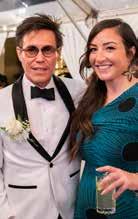


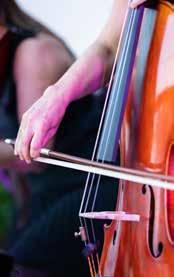



25
OPPOSITE PAGE
TOP LEFT, BACK ROW Tyler Cann, Jarad Makaiau, Andrew Law, Jim Tucker.
TOP LEFT, FRONT ROW Alejandra Rojas Silva, Amber Strong Makaiau, Rebecca Louise Law, Dr. Halona Norton-Westbroook. BOTTOM Guests relaxing in the Central Courtyard lounge.
THIS PAGE TOP RIGHT RIGHT Ella Qing Hou and J. Sanford Miller. MIDDLE CENTER Judy Pyle, Kelvin Taketa, Wayne Pitluck, and Virginia Henshaw. MIDDLE RIGHT Christopher Kahunahana and Becky Stocchetti. BOTTOM CENTER HoMA employees Haley Ross and Leoti Greywolf.
Corporate partners
FOUNDER ( $100,000 AND ABOVE)
DIRECTOR ($50,000–$99,999)
CURATOR ($25,000–$49,999)

26
Honolulu Museum of Art
Director & CEO
Halona Norton-Westbrook
Board of Trustees
Chair
Josh Feldman
Vice President
Kaili Chun
Herb Conley
Trustees
Julian K. Ako
Rajiv Batra
Mark H. Fukunaga
Priscilla Growney
Michelle Ho
Emeritus Trustees
Robert R. Bean
Mark Burak
Walter A. Dods, Jr.
Cecilia Doo
Helen Gary
Allison Gendreau
Elizabeth Rice Grossman
Alice Guild
Toshio Hara
Stephanie Hee
Vice Chair
Mike Watanabe
Secretary
Amber Strong Makaiau
Treasurer
Avi Mannis
Lynne Johnson
James Lally
Patricia Y. Lee
Violet S.W. Loo
Judith Pyle
Robert Steele
Sharon Twigg-Smith
JD Watumull
Kathleen Wo
Michael Horikawa
Robert S. Katz
Akemi Kurokawa
Watters O. Martin, Jr.
Noreen Mulliken
Patricia J. O’Neill
Cherye Pierce
James F. Pierce
Duane Preble
Jean E. Rolles
Vol. 95, No. 2, HoMA magazine is published as a benefit for the entire community:
Honolulu Museum of Art
900 South Beretania Street
Honolulu, Hawai‘i 96814
Chief Communications Officer: Kevin Imanaka
Editor: Maggie Engebretson
Contributor: Alia Orra
Design Director: Anjali Lee
Photography: Alec Singer
Jay H. Shidler
Charles A. Sted
Charles M. Stockholm
Kelly Sueda
Donna Tanoue
Ruedi Thoeni
Indru Watumull
Charles R. Wichman
Printing & mailing: Edward Enterprises, Inc.
©2023 Honolulu Museum of Art, All rights reserved.
27
Honolulu Museum of Art 900 S. Beretania St. Honolulu, HI 96814
808.532.8700

Thur & Sun • 10am–6pm Fri & Sat • 10am–9pm honolulumuseum.org

#MyHoMA
Honolulu, Hawai‘i Permit No. 119
Nonprofit Organization U.S. Postage
PAID
COVER From John Dominis and Patches Damon Holt Arts of Hawai‘i Gallery (29): Harry Tsuchidana, Beauty Contest , 1977
Oil on linen. Gift of The Contemporary Museum, Honolulu, 2011, and gift of the artist (TCM. 1982.5.1172).

 HALONA NORTON–WESTBROOK Director & CEO
HALONA NORTON–WESTBROOK Director & CEO






















































